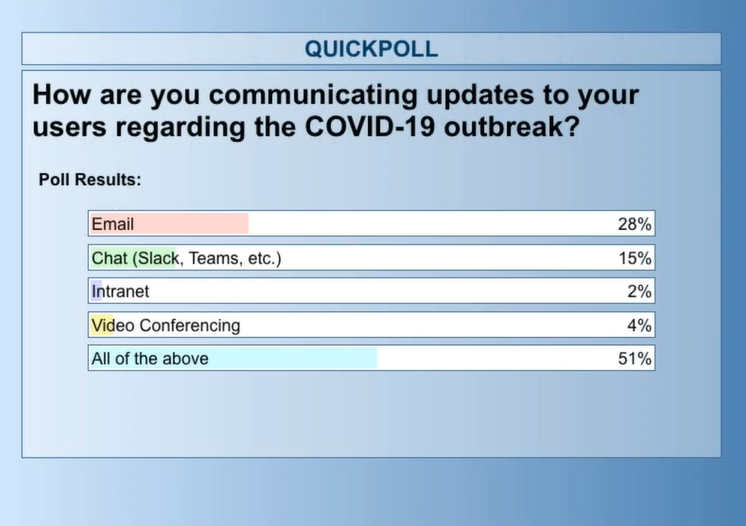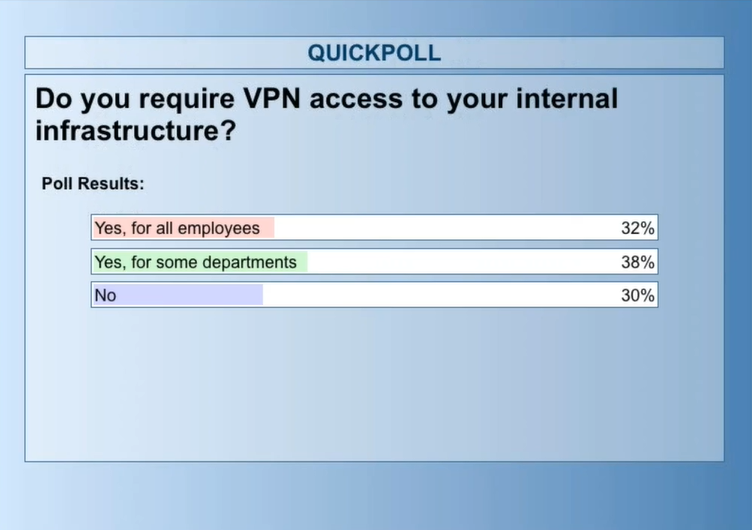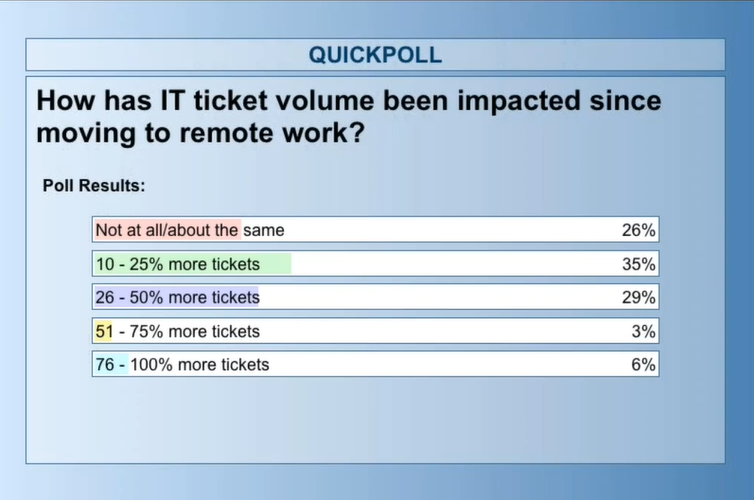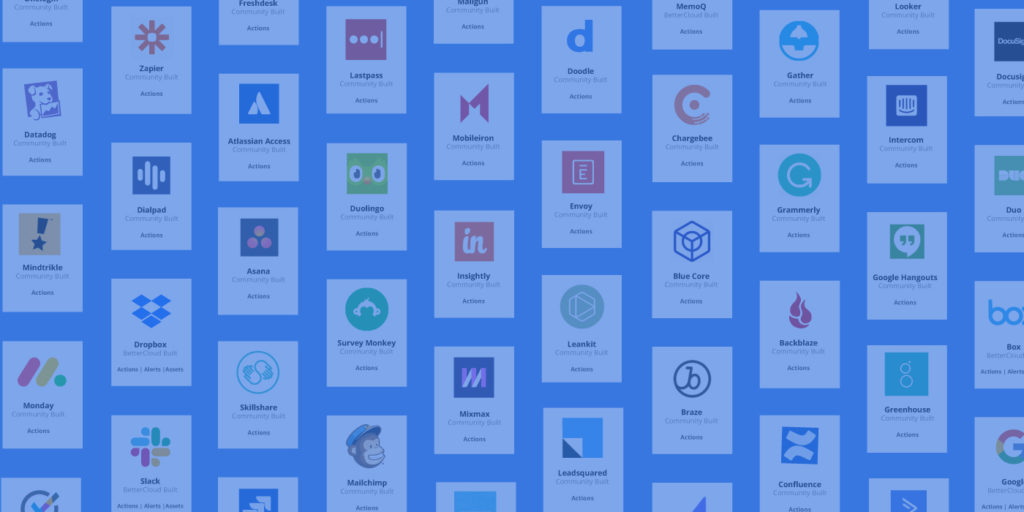IT Community Discussion Recap: IT Leaders Share How They’re Successfully Enabling Remote Workforces
March 25, 2020
7 minute read

Sometimes, it takes a community.
As fully remote workforces become the new normal, IT is facing new unexpected challenges. How do you empower end users to be productive (and secure)? How do you keep everybody updated? And logistically, how do you provide physical laptop inventory?
We recently pulled the IT community together to discuss all of this—and more. Our live chat, moderated by BetterCloud CEO David Politis, featured the following panel of IT leaders:
 Travis Whiteaker
Travis WhiteakerIT Engineering Manager, Squarespace
 Rose Layton
Rose LaytonStrategic Technology Partner, Strada Education Network
 Sean Glang
Sean GlangSenior IT Manager, Recurly
 Mike Stone
Mike StoneServices Architect, BetterCloud

Brian Farrell
IT Manager, BetterCloud
They shared what they’re seeing at their companies, how they’re managing key challenges caused by COVID-19, and how they’re keeping employees connected and secure.
If you missed it, here are the highlights from the online discussion.
To watch the entire live chat recording, click here.
How can IT empower users to be productive during this time?
First up, we wanted to know: Are teams offering technology stipends to support remote work?
We took a poll:
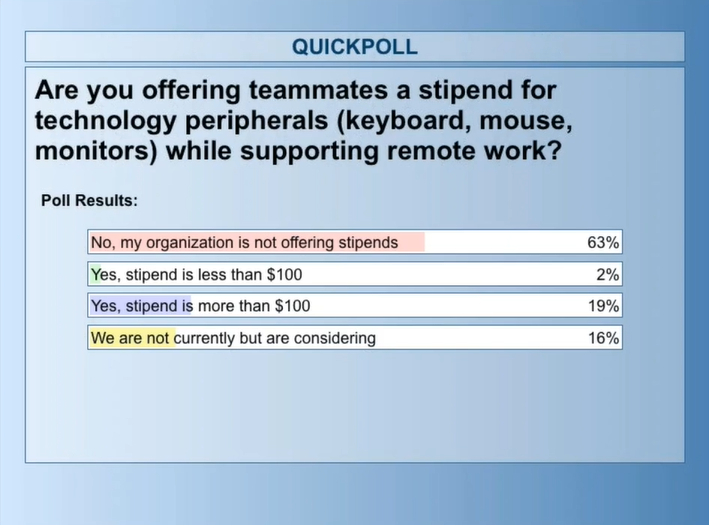
Poll results: Most respondents (63%) were not offering stipends, but 19% were offering stipends of over $100.
The panelists mentioned the importance of not sitting on your couch with your laptop, which can cause pain in your back, hands, or neck. Additionally, there’s uncertainty regarding the duration of work from home. Each panelist then shared their company’s approach.
Glang: We’re discussing stipends for things like standing desks or nice chairs, but it’s really hard. There’s so much uncertainty.
We’ve always provided a keyboard, mouse, power supply, and monitor for anyone who wants to work from home either full-time or part-time.
Layton: We already provide those things to those who want it as part of our hardware budget. We prefer people don’t buy their own items, since it already comes out of our regular hardware budget.
Whiteaker: We originally planned to allow end users to take home anything from their desk, but with large monitors, that can pose some logistical challenges. Also, with social distancing, and some locations sheltering in place, logistics of getting to the office don’t always fit. So we’re taking it on a case-by-case basis. If end users ask, we’ll ship it directly to them, although we haven’t set a definitive policy for expenses. This was such an unanticipated budgetary expense.
Learn how BetterCloud can help IT enable remote employees to stay productive, connected, and secure.
Shifting from in-office culture to fully remote
Although we’re an in-office culture at BetterCloud, we set ourselves up for success as much as possible through our regular business practices. All services are accessible one way or another through the internet, so people are able to work remotely by design. We had to increase infrastructure to accommodate more people accessing resources remotely.
Farrell: We’re fortunate that as a tech company, most employees are tech literate. Now it’s just “same job, new location.”
This is a SaaS tipping point: “There will be second and third order effects from this”
“We talk about the important role of IT, and this is the moment where it all comes to light,” Politis said.
“Companies who are laggards running legacy infrastructures have seen productivity go to zero. This is a tipping point for the adoption of SaaS.”
Glang agreed it’s an inflection point in the industry. And several panelists noted the cost savings due to eliminating expenses such as food, travel, and employee events, which could be redirected to employee engagement or other resources.
Layton: There will be second and third order effects from this, and we have no idea what they’re going to be, although I’m trying to look forward. It’s so important to keep your end users and the company in a change-adaptable mindset.
Stone: This may start a whole wave of working from home as people adopt these tools and become more comfortable. That may bring its own problems and benefits.
The changing pace and medium for company communications: What is IT doing to keep everyone updated?
All of our panelists’ organizations have increased the frequency of communication, and they agree that more information is better.
Layton: The cadence of company communications has increased, with biweekly emails in some orgs, and the CEO is sending updates nearly every day. The lack of communication early on was difficult for people. Things are changing daily, and people want to hear the updates.
Whiteaker: Email seems to be the best medium to ensure everyone is getting the right information ASAP.
At this point, more information is better. It shows a level of transparency as the situation unfolds. We’re working to adapt to “the new norm.”
Glang: Our formal meetings have stayed on the same cadence. We’ve focused more on team meetings than company-wide, with two team meetings per day. We’re also looking to foster the more informal communications and the chatter that we’ve lost amongst co-workers, specifically with a “watercooler” Slack Hangout.
Farrell: We’ve been communicating via email at the pace of things changing, as well as holding company-wide Zoom meetings twice a week. Shifting company-wide meetings to Zoom has enabled us to become more nimble. It’s not as much of an intrusion into people’s days.
Politis: I’ve been missing interaction with other people and seeing our customers face to face.
Effectively securing work from home environments
Farrell: We use VPN and require it for access to some things, such as things in GCP. The majority of our systems are SaaS apps such as Gmail, which you don’t need a VPN for. We recently completed a VPN migration, which made things more secure. However, we didn’t have enough licenses to support every single person signing into the VPN at the same time, so we had to acquire emergency licenses. It was a bit of a scramble, but our hardware has been able to support it.
Layton: If you don’t know what “Zero Trust” and “BeyondCorp” are, you should Google those terms today. Those are the future.
Logistics regarding shipping, laptop distribution… and the value of doormen
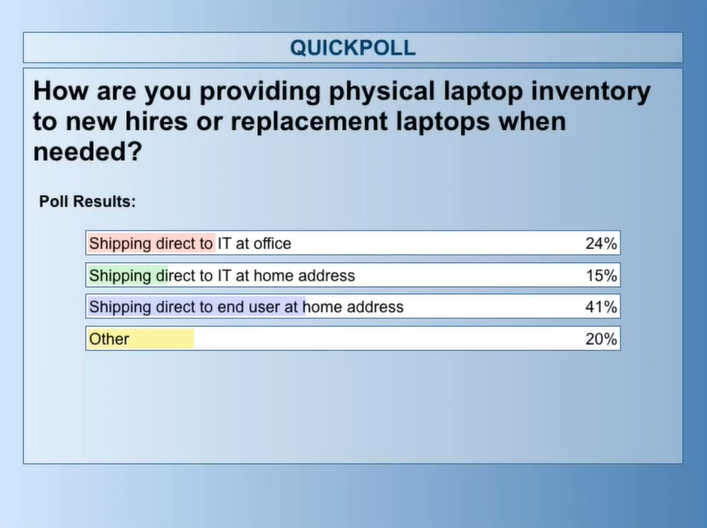
Poll results: Nearly half (41%) of respondents are shipping physical laptop inventory directly to end users at their home addresses.
How are panelists providing physical laptop inventory to new hires when needed?
Layton: We don’t have a single, one-touch solution for rolling out new laptops. Something to consider is that IT staff might not have insurance for extra hardware inside their homes to do the onboarding work. We’ve been shipping to IT at the office, setting them up there, then shipping to the end users.
Recently, we’ve had just one person in the office at a time to restrict exposure. Today [March 18] is our last day in the office, and we’re gathering supplies such as spare keyboards and loaner laptops, which we’ll be distributing throughout the team.
Glang: I don’t want to turn this into a commercial for BetterCloud, but man, am I glad we have it! So much easier to hit that button than to go through spreadsheets. For offboarding, we’re planning on having laptops shipped to an IT person’s house for them to keep in their garage for a month.
Whiteaker: Apple’s supply chains are drying up fast, which will pose a very large problem for us soon. This has illustrated the importance of having multiple suppliers in place ahead of time.
Farrell: The BetterCloud team determined who can accept packages and has computers shipped to someone who has a doorman to confirm delivery.
What is the one biggest thing that’s changed in your day-to-day work?
Glang: Most of the non-IT questions from end users used to be in person, and now they’re coming in as tickets in a formal way. Someone can’t just get up and walk them over to another person’s desk. That “soft layer” that was on top of our real responsibilities is now taking up more of our time.
Layton: Rethinking things like communication strategies, how to get info out, how to replicate in-person things. One of the biggest comments that IT and other departments have gotten is figuring out how to connect with co-workers and be social.
Whiteaker: We’ve seen an increase in tickets such as VPN and requests for equipment at home. Once solved, they’re usually not recurring, but the normal issues we’re used to seeing have decreased somewhat. I attribute this to end users being in the process of figuring out the new norm to continue with their work.
Farrell: We’re having a lot more meetings about ways to proactively support people and discussing logistics. If ticket volume decreases, does that mean things are fine, or they don’t know what to do?
Politis concluded the discussion with this sentiment: IT is an important enabler at the center of this, and they’ll come out the other side stronger and with more budget.
“In This Together” is one of BetterCloud’s four company values, and we feel it more than ever right now. We’re here to help. We’ll be hosting more upcoming panel discussions on remote work topics, so stay tuned.
We’re #InThisTogether. Join BetterIT, our Slack community, to chat with thousands of your peers who are facing the same challenges. Check out the #remote-it channel to keep the conversation going and learn more about enabling a remote workforce.



